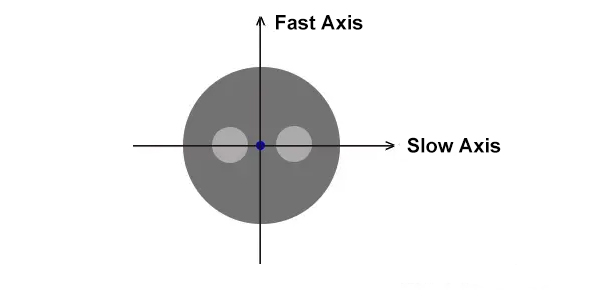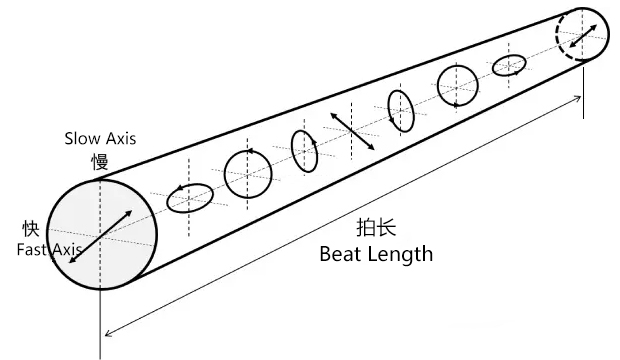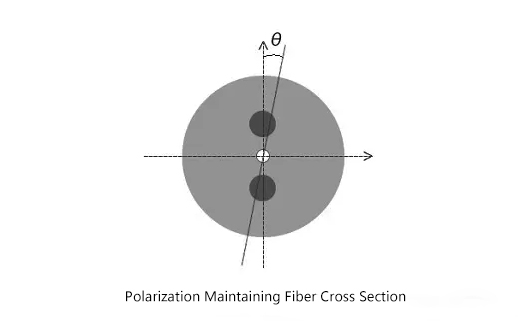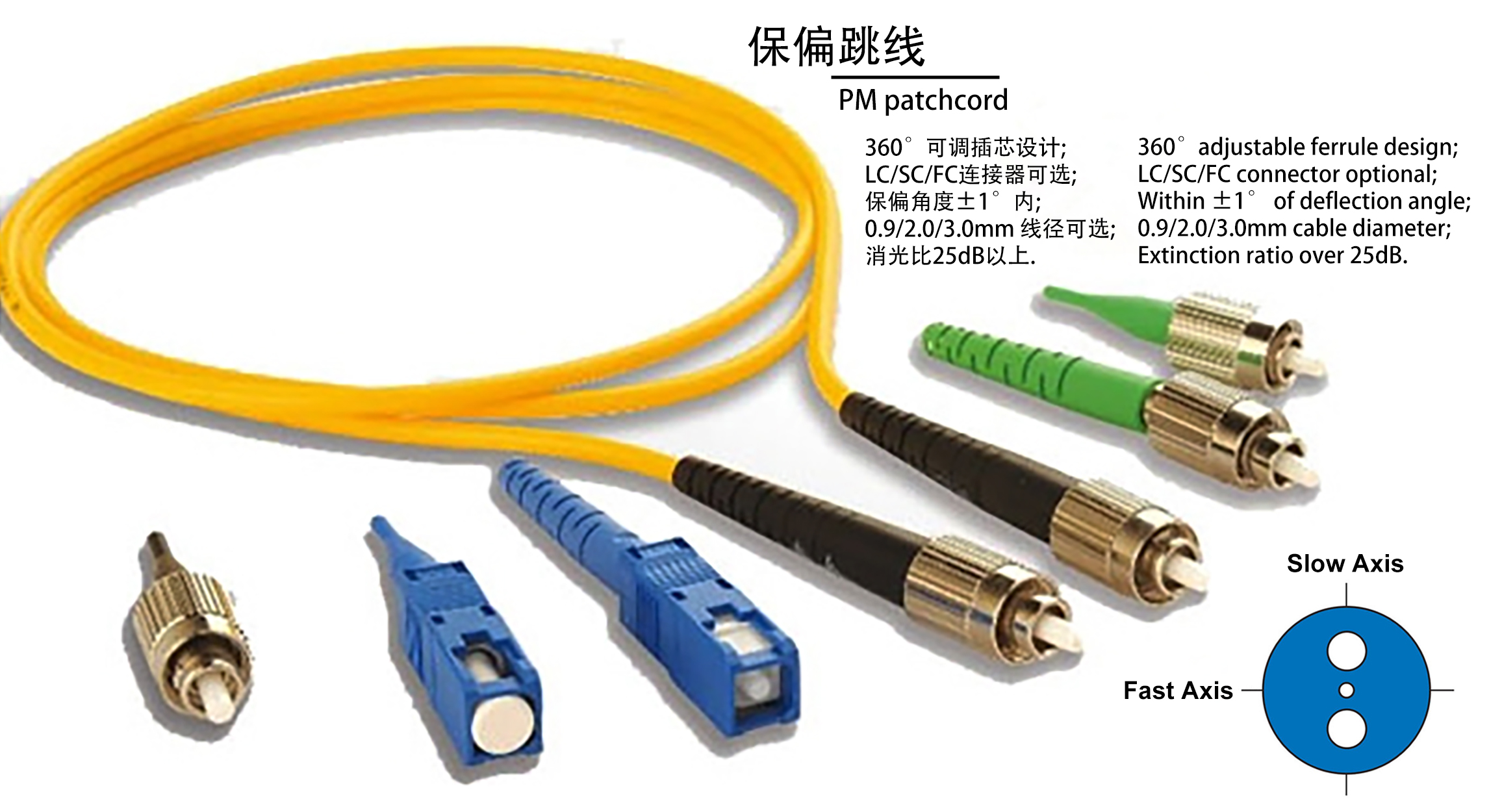What’s the Fast and Slow Axis?How to Align the PM Fiber?
What’s the Fast and Slow Axis?
Polarization Maintaining fibers work by inducing a difference in the speed of light in the two perpendicular polarizations passing through the fiber. This birefringence creates two major transmission axes within the fiber, called the fast and slow axes of the fiber. The fast axis is the direction of the small refractive index, the faster optical axis of light transmission, perpendicular to the midpoint of the line connecting the centers of the two stress zones; the slow axis is the optical axis that passes through the end of the two stress zones, the direction of the large refractive index, and the slower transmission speed.

What is Beat Length?
If the direction of polarization of the incident polarized light coincides with the fast or slow axis of the optical fiber, the polarization state of the light remains unchanged during transmission. If the direction of polarization of the incident light and the fast axis or slow axis into an angle, will be excited at the same time the two propagation constants of different orthogonal polarization modes, the two polarization components of the power of the period between the exchange, this period is called beat length. The beat length is a very objective parameter of the degree of fiber birefringence, which has no relationship with the fiber length, polarization and alignment of the input light, and can well reflect the periodic change of the polarization state of the fiber. Periodicity refers to the process of polarization state along the length of the fiber from line bias → elliptic bias → circular bias → elliptic bias → elliptic bias → line bias → elliptic bias → elliptic bias → line bias, and returns to the original line bias state after an integer number of beat lengths.

Polarization Maintaining Beat Length
The formula for beat length is Lp=λ/B, λ wavelength, and B is birefringent. The smaller the beat length, the greater the difference between the speed of light in the fast and slow axes, and the stronger the birefringence performance. Typical B values: ordinary fiber B = 10 (-7), bias-preserving fiber B = 10 (-4)
What is extinction ratio?
The principle of polarization preservation is achieved by aligning the direction of polarization of polarized light with one of the axes, so that the polarization component to the other axis is small, thus maintaining the polarization state of the transmitted light. The extinction ratio (ER) parameter is introduced to reflect the degree of excellence of the fiber in maintaining the polarization state. When the polarization direction of polarized light is aligned with one of the fast and slow axes, two orthogonally polarized modes are generated through the component, and the ratio of the polarized component along the original direction axially to the polarized component in the perpendicular direction is the extinction ratio. The extinction ratio is an important parameter for measuring the quality of a polarizer. The larger the extinction ratio, the higher the quality of the polarizer.
ER = 10 log(Pmax/Pmin)
Polarization Maintaining(PM)Patch Cord Working Principle
Polarization Maintaining Patch Cord is designed to achieve polarization mode coupling alignment through precise connector bonding. Compared with traditional fiber optic patch cords, polarization maintaining patch cords have the advantages of polarization maintaining fiber transmission of polarized optical signals, which can ensure the direction of line polarization remains unchanged, improve coherent signal-to-noise ratio, and achieve high precision measurement of physical quantities.
Bias-preserving connector is an important component for coupling two bias-preserving optical fibers to ensure that the polarization modes of two bias-preserving optical fibers maintain the original polarization state of the polarized light during coupling, and maintain a high extinction ratio for transmission. This requires precise alignment of the slow or fast axis in the two fibers to minimize the theta angle error. By aligning the direction of polarization of the polarized light with one of the axes, the polarization component divided into the other axis will be small, thus maintaining the polarization state of the transmitted light. The polarization preserving angle and extinction ratio are reflections of the degree of excellence in maintaining the polarization state.

How to align the “panda’s eye”?
The stress bar is parallel to the fiber core, and the applied stress creates birefringence within the fiber core, which facilitates polarized light propagation in only one direction, thus maintaining polarization preservation. Panda-type stress rods are cylindrical, while bowtie-type uses trapezoidal prismatic stress rods.
In general, the polarization preserving fiber maintains the polarization state depends on the incident state of the polarized light, which requires the polarization state of the polarized light to be aligned with the coupling of the fast and slow axes of the polarization preserving fiber. To ensure that the two fibers are transmitted with a high extinction ratio, it is necessary to ensure that when the polarization-preserving fiber is terminated through the fiber connector, the stress bar should be aligned with the connector key. whether the key is aligned or not directly determines the function of the link transmission of the polarization-preserving connector, which is a very critical indicator.
Stress bar to be aligned with the connector key key, the conventional production practice on the market is: in the core filled with 353ND curing adhesive, in the glue is not yet fixed, by rotating the core in the magnifying glass under the alignment of the stress bar (panda’s eye), alignment and then curing. The problem is that, after aligning the “panda’s eye”, you need to move the connector for baking and curing, the core is very easy to rotate, and curing adhesive there is a certain viscosity, resulting in alignment in the curing of the core before the rotational offset, “panda’s eye” alignment angle The alignment angle of the “panda’s eye” can only reach ± 5 degrees or less, and the extinction ratio of the whole patch cord can only reach more than 20dB. And once the offset angle is too large, the connector end must be cut to re-add head, a waste of time, and the quality is difficult to guarantee.
In order to solve the above problems, neofibo independently designed a 360-degree rotating insert to align the “panda’s eye” to keep the offset connector. By rotating the cured core instead of rotating the fiber optic cable core, when the “panda’s eye” alignment, and then fix the core tail Bing, to achieve the purpose of accurate positioning. After verification, Neofibo series of bias-preserving connectors can control the deviation of alignment angle within ±1 degree, and the extinction ratio can reach more than 25dB.

Where is the PM Fiber Application?
PM fibers are generally used in applications that are sensitive to polarization states, such as interferometers, or lasers. It is also often used in sensors such as fiber optic gyroscope, fiber optic hydrophone, and fiber optic communication systems such as DWDM and EDFA.
With more than 20 years of experience in R&D and manufacturing of passive optical components, EYT Technology can provide customers with customized fiber optic connectors, patch cords, PLC splitters, WDM WDM multiplexers, MEMS optical switches, circulators, couplers, hybrid devices, etc. EYT has launched a series of self-developed and self-developed optical components, which are widely used in fiber optic communications, such as interferometers, or lasers. Everest has launched self-developed conformal fiber optic connectors and patch cords with 360° rotatable inserts, including LC\SC\FC connector types.



